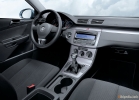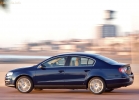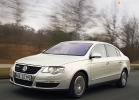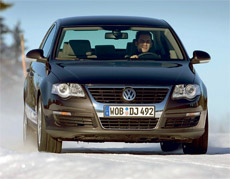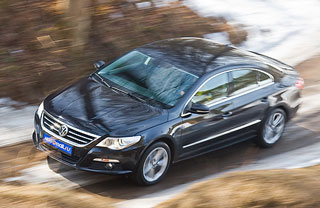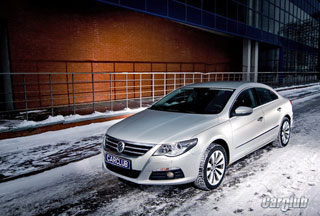Test drive Volkswagen Passat B6 2005 - 2010 sedan
Compartment in a square
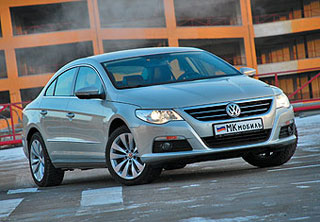 Formally, the compartment is a two- or three-breeze passenger car with two side doors and two rows of seats. But recently, manufacturers have been interpreting this type of body how it pleases. Mercedes-Benz made a four-door CLS, actually declared himself a revolutionary. And now, the folk Volkswagen, who introduced the public Passat CC, heeded the impulse of compatriots.
Formally, the compartment is a two- or three-breeze passenger car with two side doors and two rows of seats. But recently, manufacturers have been interpreting this type of body how it pleases. Mercedes-Benz made a four-door CLS, actually declared himself a revolutionary. And now, the folk Volkswagen, who introduced the public Passat CC, heeded the impulse of compatriots. What is characteristic, the Germans and this time managed to finalize the long -suffering classification: hitherto abbreviation SS meant that the car rewarded with it has not only two doors, but also a transformed roof. So, this does not concern the new modification of Passat: not only does it have four doors, but the roof is also not removed. As for the name, the Germans thus simply reduced the definition of a comfort commander invented by them.
But really, why puzzle? The client will somehow figure it out, and the compatriots producing cars will have the next reason to nervous: the appearance in the Volkswagen line of such an impractical toy once again proves that the company did not refuse the plans for conquering the premium segment.
The fact that Passat CC is made for a more wealthy layer of European society is obvious. Formally, he retained the features of the sedan of the same name, but in reality the stylists had to modify or re -make literally every body panel. The SS front, for example, is a little longer and squeezing, its front racks are more inclined, the roof has become more pier and, by the way, almost ideal from the point of view of geometry. In general, the style here, as always, is impeccable. But the main thing, unlike the sedan’s obviously family in mood, has the novelty has the same charisma that is not in any of the modern VW models (and for a long time). Of course, we can say that the muscular arches and powerful ribs on the sides are spied on relatively fresh Mercedes C-class, and the profile of the car turned out to be too Asian. You can complain about the excessively heavy stern and uncharacteristic for the brand of the spread lamps ... But, on the other hand, it is thanks to this (maybe even alien and non -traditional) elements of Passat CC that has gained individuality. It became not just a solid, but noticeable and bright as a premium (or claiming title) car should be.
Alas, the designers did not have enough for the interior design. Yes, aluminum on the panel, excellent plastic, leather, frankly sports and, as always, comfortable chairs add respectability to a respectable car, but the salon of a civilian sedan in the compartment looks, to put it mildly, not impressive. You expect more orientation to him on the driver, which is very well implemented, for example, in the last Audi, right there the same symmetry and Teutonic severity. However, it is possible that the preservation of the corporate passato style is quite conscious, especially since the Germans did not finally breed a novelty with the donor family.
There are, however, and considerable advantages. The first ergonomics. The functional component here, as in the sedan, deserves the highest assessments everything is calculated to the smallest detail. Second comfort. As in any other VW, the driver and the front passenger have problems with landing and selecting the right adjustments by definition. True, they can arise when planting, at least in people with high stature: in order not to apply to the crown of the front rack, they will have to constantly control the supply of vital space, otherwise the contact can be very painful.
But unlike most formal SS competitors, it has a full -fledged four -seater salon. The Germans did not shout their souls and cut the rear sofa under two passengers. The central roller is absent here as a class, so placing someone there will not work there. The remaining pair of seats will easily take two full -sized inhabitants into their arms, providing them with more than a decent level of comfort. The only restriction is height: the ceiling here is still lower than in the sedan. But it is unlikely that this will upset the driver, because the coupe is not bought for family entertainment, but for their own.
By the way, the SS is all right with this. Trivo with three gasoline engines are available to Russian clients, the weakest of which (1.8 TSI) produces 152 hp, and the most powerful (3.6-liter V6) 300 hp. There is also a 2-liter turbodiesel, but it is unlikely to be any noticeable against the background of the units traditionally popular with us. There are also three boxes: manual transmission, mandatory for each VW DSG and a 6-speed machine. It was he who worked in tandem with a 200-horsepower TSI installed on a test coupe.
The two -liter turbo engine for the author of these lines is not news, but this tandem is very good: there are enough of those that he spends on a set of 100 km/h, for such a car, for such a car. But I liked the box more: judging by the manufacturer, the automatic transmission switches slower than the prefellective DSG, but it is difficult to feel this difference in practice (firstly, it is no less quick, and secondly, it is correctly configured). Plus, you should not forget about the engine settings: the maximum traction (280 Nm) is already available at 1700 rpm, which allows the use of automatic transmission with maximum efficiency. In general, with active pedaling, the car does not disappoint the rides thoroughly.
But without enthusiasm. The steering wheel, pendants and brakes work well, the car is comfortable, obedient and stable enough, but it does not fall to the unquestioning fulfillment of the driver's desire. However, the Germans immediately said that Passat SS was addressed not by mythical customers, but by sophisticated fans of a model who preferred to possess a slightly more original car with a slightly more sports character ...
Vladimir Zhidkov
Photo: Armen Meitarjan
Source: Mkobil magazine [April/2009]
VOLKSWAGEN PASSAT B6 2005 - 2010
Volkswagen Passat B6 2005 - 2010 test drives
Krash Test Volkswagen Passat B6 2005 - 2010
Krassh Test: Detailed Information34%
Driver and passengers
17%
Pedestrians
38%
Children-passengers
Malfunctions Volkswagen Passat B6 2005 - 2010
Volkswagen Passat malfunctions: Detailed information| Passat B6 2005 - 2010 | |
|---|---|
| Engine |  |
| Transmission |  |
| Control system and suspension |  |
| Brake system |  |
| Air heating and air conditioning |  |
| Launch and charging system |  |
| Electric components and so on |  |
| Corrosion body stability |


